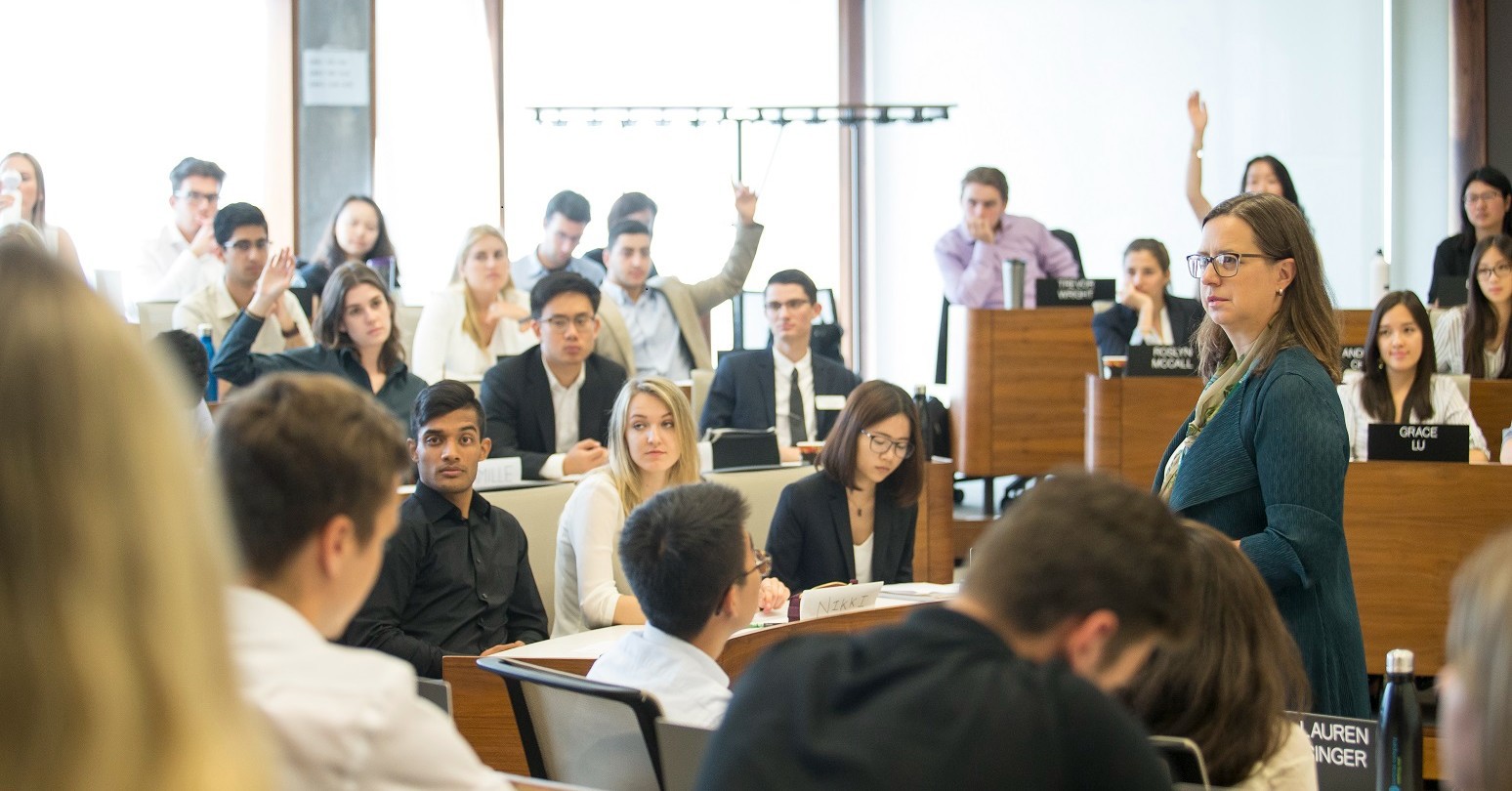Ivey is well-known for its case-based approach to learning that enables students to work with actual business challenges faced by real leaders. It’s an approach that prepares students to quickly analyze information, make decisions, and defend them so they can tackle critical workforce issues with confidence. But there can be an adjustment period as students get used to this participatory, discussion-based way of learning. Below six Ivey faculty members share tips for making the most of the experience, from reading the cases to collaborating with others.
Zoe Kinias’ tip:
Consider the perspective of the case characters as well as your own

Zoe Kinias is an associate professor of Organizational Behaviour and the John F. Wood Chair in Innovation in Business Education
To get the most from case learning, Zoe Kinias says it’s essential to analyze with both depth and breadth while focusing on what's relevant for a particular course or session. This means identifying the most relevant details and iterating between them and what they signal in the context of the key decision(s) to be made in the case. She suggests going beyond bringing your own perspective to also considering what makes sense for case characters, based on what you know of them and their contexts.
For the topics I teach – on leadership and the human side of business – it is important to first consider what makes intuitive sense to you as a reader. Next, testing this against course learnings that inform what makes sense for the protagonist given their context becomes key,” she said. “This perspective-taking and analysis in the context of theories and frameworks can stretch beyond initial responses for deeper learning."
– Zoe Kinias
David Wood’s tip:
Engage in a three-step learning process
 David Wood, HBA ’97, MBA ’12, is a lecturer of Operations Management
David Wood, HBA ’97, MBA ’12, is a lecturer of Operations Management
Learning with cases is more fulfilling if you are convinced that how you are learning makes sense. David Wood says there is a proven three-stage learning process and each stage contributes in different ways to the quantity and quality of learning.
The three stages include:
- Individual preparation – Sizing up the case, reading it thoroughly, and preparing your own case analysis and decision;
- Small group discussion – This provides the key link between individual preparation and class or large group discussion. Gather together a group of three to five students to each share key ideas and insights; and,
- Large group discussion – The diversity people bring to the group discussion is enriching. The secret to effective participation in large group discussions is to listen and think at the same time.
Participants in a case learning experience are always constrained by time. Your goal is to learn quickly and thoroughly by engaging in this process repeatedly."
– David Wood
Alison Konrad’s tip:
Study materials on the concept before reading the case
 Alison Konrad is a professor of Organizational Behaviour
Alison Konrad is a professor of Organizational Behaviour
Since a key goal of a case class is to explain theories and concepts through the use of case examples, instructors often ask students to read a preparatory chapter or article beforehand.
Alison Konrad says, when that happens, the instructor is looking for student insights that link the case to the reading. She recommends students always study that material before reading the case. Be sure to make notes that capture the main idea and supporting points from the article.
Now you’re ready to read the case, but take your time, says Konrad. Highlight important parts that can be linked to the class concepts, or concepts from prior classes.
Never highlight anything without adding a comment explaining why you did the highlight, says Konrad. This process will slow you down so that you really think about each section of the case. By the time you come to the end of the case, you should have notes indicating where each of the main events is described in the text as well as where the issues arise that provide links to class concepts.
Raise your hand in class and explicitly link your comment to a class concept – either from the past or new – and you will make your instructor very glad they called on you."
– Alison Konrad
Martha Maznevski’s tip:
Read, pause, take notes, read some more – then analyze
 Martha Maznevski, PhD ’94, is professor of Organizational Behaviour and Faculty Director for Executive Education
Martha Maznevski, PhD ’94, is professor of Organizational Behaviour and Faculty Director for Executive Education
When you’re reading a case, it’s easy to get lost in the weeds with all the details. Martha Maznevski recommends you read the opening page, then pause and take notes about what the decision-making problem is and what kind of information you would need in order to solve it or address it.
Then read the whole case relatively quickly, making short notes about how different sections align with your initial assessment (or challenge it!).
Now you can begin your analysis.
You’ll have a good overall picture of the situation, and you’ll be better able to identify which kinds of analyses you want to dive more deeply into, to address the challenge the decision-maker is facing. You won’t get lost in the weeds, and you’ll know how to combine the information for a good solution.”
– Martha Maznevski
Mary Gillett’s tip:
Resist the temptation to find out what really happened

Mary Gillett, HBA ’82, MBA ’02, is a lecturer of Managerial Accounting and Control and Faculty Director of the Executive MBA Program
Since many of the cases discussed in class are based on real events in real companies, it may be tempting to search on Google what the company actually did. Mary Gillett warns that doing so will make you miss out on thinking about what might have been an even better path for the company to have followed.
And, if you do happen to know what the company did, it’s best to keep it to yourself, she says.
Blurting out that ‘right’ answer, particularly early in a class discussion, can really shut down the conversation … and that’s good for no one!”
– Mary Gillett
Paul Beamish’s tip:
Embrace the energy and enjoy the ride
 Paul Beamish, HBA ’76, PhD ’84, is a professor of international business and general management
Paul Beamish, HBA ’76, PhD ’84, is a professor of international business and general management
Paul Beamish vividly recalls his first case-method experience as an HBA1 student in September 1974.
“The energy in the classroom with the case method was like nothing I had seen before,” he said.
Beamish says that energy remains and is still invigorating 48 years later. He encourages students to make the most of the experience. Read and think about the assigned cases in advance and then actively participate in class.
You won’t always be right, but you will learn some things, which will help you over the next half century. Among these are critical thinking skills, how to frame an argument, and an appreciation and respect for the views of others. Enjoy the ride!”
– Paul Beamish
Kanina Blanchard’s tip:
Embrace the value of others and collaborate
 Kanina Blanchard is an assistant professor of Management Communications and General Management
Kanina Blanchard is an assistant professor of Management Communications and General Management
Kanina Blanchard has a unique analogy for Marvel fans: think about The Avengers when preparing for cases. Each individual on the superhero team is pretty amazing, bringing a unique story, strengths, and challenges. But together the superheroes can take on the toughest of challenges. When one struggles, others step in to support. They share leadership. They find a way to collaborate.
Blanchard says to start with the idea that, as a smart and capable student, you bring knowledge, experiences, and ways of thinking and problem-solving that have served you well. But at Ivey, you will be stretched and challenged to not just keep doing what you already know how to do. To accelerate your learning and contribution, embrace the value others bring. Harness the power of purpose, working on a shared and unified goal.
“You will likely work in a team in which you may connect immediately with some, and not so much with others (think about Tony Stark and Steve Rogers). Going at it alone will not only be isolating, but also less successful (think about The Hulk),” she said. “Together, you will have to find ways to enable everyone to express their opinions, sort through disagreements, and deal with frustrations. But it is the journey, with all its trials and tribulations, that creates the greatest learning experiences.”
It starts with you, gets better with a team, and as a class you will be The Avengers... Avengers Assemble!”
– Kanina Blanchard



